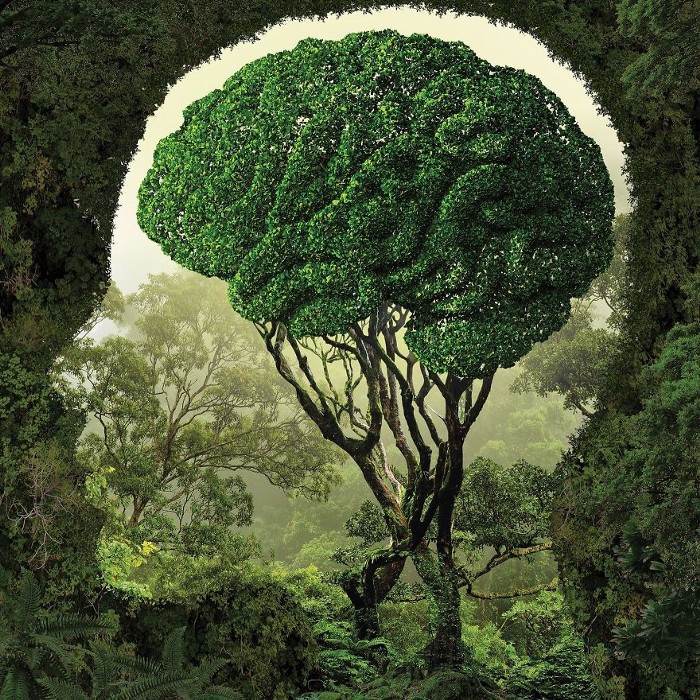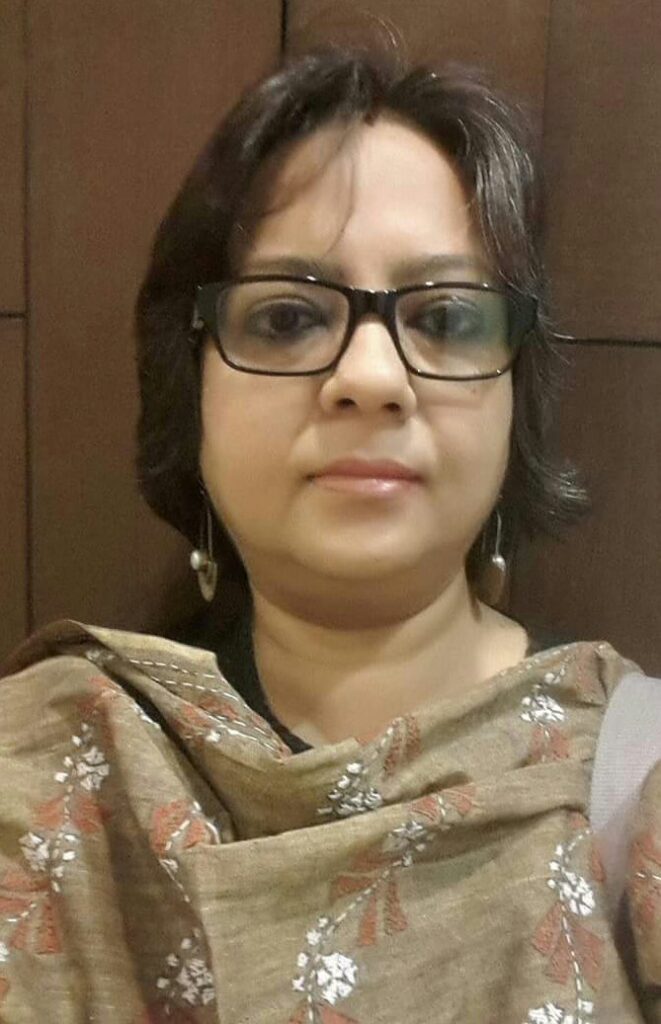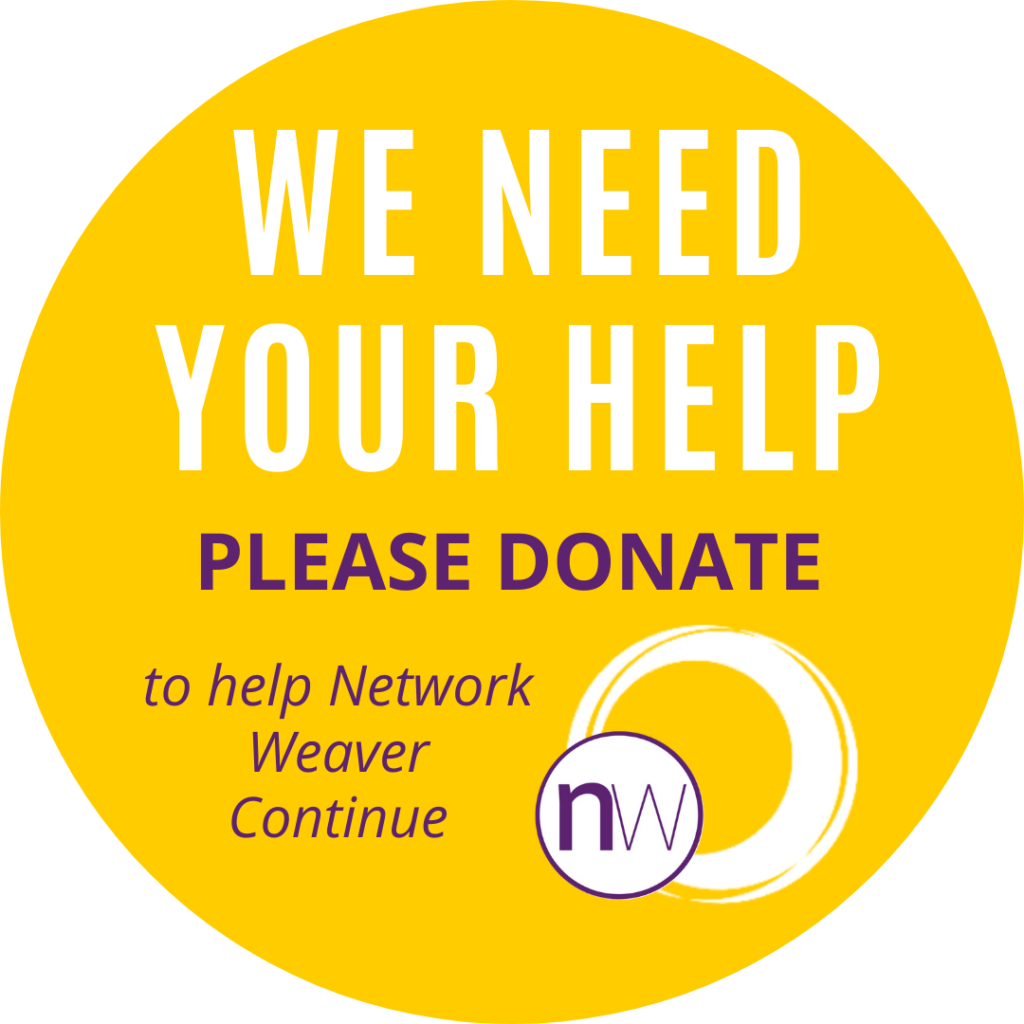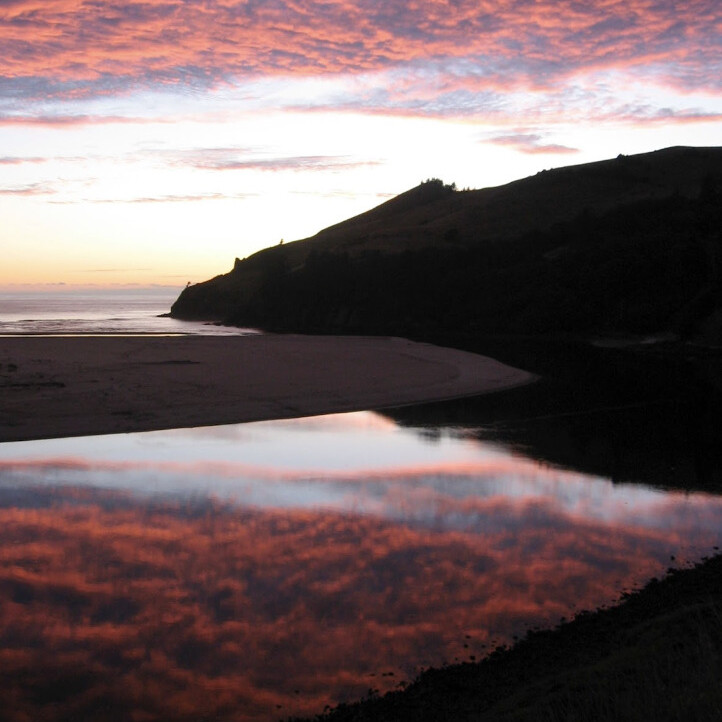The questions we ask today will define the future we create tomorrow…
When the Stranger says: “What is the meaning of this city?
Do you huddle close together because you love each other?”
What will you answer? “We all dwell together
To make money from each other”? or “This is a community”?
Oh my soul, be prepared for the coming of the Stranger.
Be prepared for him who knows how to ask questions.~ T.S. Eliot, The Rock
The reckless and rapacious excesses of the politicians, the converging crises — from the pandemic to natural disasters to socio-political collapses, the years of systemic and structural inequities and imbalances, and failing economies have all culminated to a point where the whole world is blowing up in our face. The situations may be as diverse as the long march back home for Indian migrants, the anti-CAA protests in India, or the eruption of anger against the killing of George Floyd in the U.S.A.
However, underlying the surface differences are deep-seated common ills: resounding failure of structures and systems built on narratives of privilege, power, and profit, the “othering” and oppression of the “different” and dispossessed, marginalization and brutalization of the perceived enemies of mainstream political agenda, and an overbearingly extractive, exploitative, and exclusive economy. But now the Stranger Eliot wrote about is here in the form of the pandemic. And it is forcing us to ask ourselves some very tough questions.
As the virus sweeps across nations, an obsolete and failing world order stand revealed in the form of increasingly draconian and dictatorial policies, unchecked police brutalities, political perfidies, economic turmoil, and deep social inequities and injustices. The world that has been teetering on the brink for a long time has now tilted over into chaos.
The blizzard of the world
Has crossed the threshold
And it’s overturned the order of the soul.
~Leonard Cohen
But tenuous sparks of hope are visible against this dismal and disorienting backdrop in the form of communities of people rising in protest against decades of discrimination, in solidarity with their fellow humans, in anger and anguish but with unflinching faith. And it is this unwavering belief, this fierce commitment toward co-creating a “world that works for all,” this refusal to be subjugated frightens the powers that be.
So, they double down on polarizing, dehumanizing, and concocting “fake enemies,” keeping alive an environment of constant unrest and turmoil. The last thing they want are people recognizing and honoring their deep inter-connectedness and inter-relatedness with each other. Perhaps not surprisingly, acknowledging our inescapable and ineradicable inter-connectedness is precisely the lesson the pandemic seems to be driving home.
The grand design of the pandemic appears to be to simultaneously underscore all the fault-lines while giving us opportunities to re-imagine a different and thrivable future. It is shining a light on our civilization’s shadows so that we can collectively, courageously, and creatively overcome them. For centuries, we have sustained and propagated the Story of Separation. We have tolerated and submitted to systemic inequity, injustice, and intolerance. We have, for far too long, averted our gaze while the answer was always blowin’ in the wind. It is time now to step into the Story of Interbeing.
As individuals, we dream of an abundant, thriving, and resilient world, but we do not have the capacity to actualize it. Yet, when we come together as intentional communities, we have immense power to effect change. The pandemic is asking us to honor our inter-relatedness and offer our collective wisdom in the service of envisioning and actualizing a regenerative future. This is an opportunity to hospice what no longer serves us and midwife the seeds of a future based on the principles of Interbeing.
“There is no power for change greater than a community discovering what it cares about.” ~Margaret J. Wheatley.
This article is a tentative exploration into the possibilities, promise, and qualities of intentional communities of diverse and committed individuals collectively exploring this liminal space we are in, honoring and deeply living the questions, and holding the space for what wants to emerge. The power of privilege running rampant the world over can only be countered by the purpose of communities.
It is axiomatic that we are at a threshold in human existence, a fundamental change in understanding about our relationship to nature and each other. We are moving from a world created by privilege to a world created by community. ~Paul Hawken
These communities must necessarily be diverse. Only by inviting and respecting a kaleidoscope of perspectives and worldviews, expertise and experience, seeing and sensemaking capabilities can the communities co-create narratives and metaphors that move us toward an emergent future. By aligning remarkably diverse people around a purpose, the communities help us to see and sense the world through a multiplicity of lenses so that we avoid the dangers of a single story. Thoughtfully designed and facilitated communities become crucibles and evolutionary spaces for generative conversations and insightful synergy among varied perspectives, thus giving rise to new ways of being and acting in the world.
The communities also become spaces for co-evolution as people embark on a journey of individual and collective transformation, a voyage of envisioning and co-designing a thriving world, a quest for “what it means to be a human being on this planet.” Since we cannot become harbingers of transformation if the source of our thinking remains the same, we must also honestly examine our assumptions, beliefs, value systems, and worldviews — the source of every thought, word, and deed. Communities become safe holding spaces for delving into such inquiry, which would, otherwise, have been too daunting for us to take up on our own.
This rediscovery of the value of community has the potential to be the most important factor of all in shaping the trajectory of the next era. New ideas and political possibilities are critically important, but ultimately an era is defined by its underlying values, on which everything else is built.
What are the questions we must hold close to our heart? What are the questions that can become our compass on this journey? Can we see Covid19 as a healing crisis, a driver of a deeper cultural transformation?
We need new stories that can galvanize global collaboration and guide a collective response to the converging crises we are facing. Intentional communities become the creative playground for the co-creation of new narratives — stories and metaphors that are compasses toward a more beautiful world our hearts know is possible.As the world teeters on the edge, communities have the power to break the status quo and become the “imaginal cells” nurturing and midwifing a transformed, regenerative future.
May the best among us, the most visionary, the most inclusive, be the imaginal cells — for now we are in the soup. ~Rebecca Solnit
o What attributes, processes, and practices does a community of true belonging have?
o How can a community build an atmosphere of authenticity and wholeness where it is not necessary to “perfect, please, prove, or pretend”?
o Why does this global calamity ask for communities? What are the drivers?
o How can the culture of increasing divisiveness affecting the globe be countered by communities of belonging?
o How can communities hold space for the emerging stories?
In this section, I explore some of the qualities and features of purposeful communities. I have attempted to synthesize these in the diagram below:
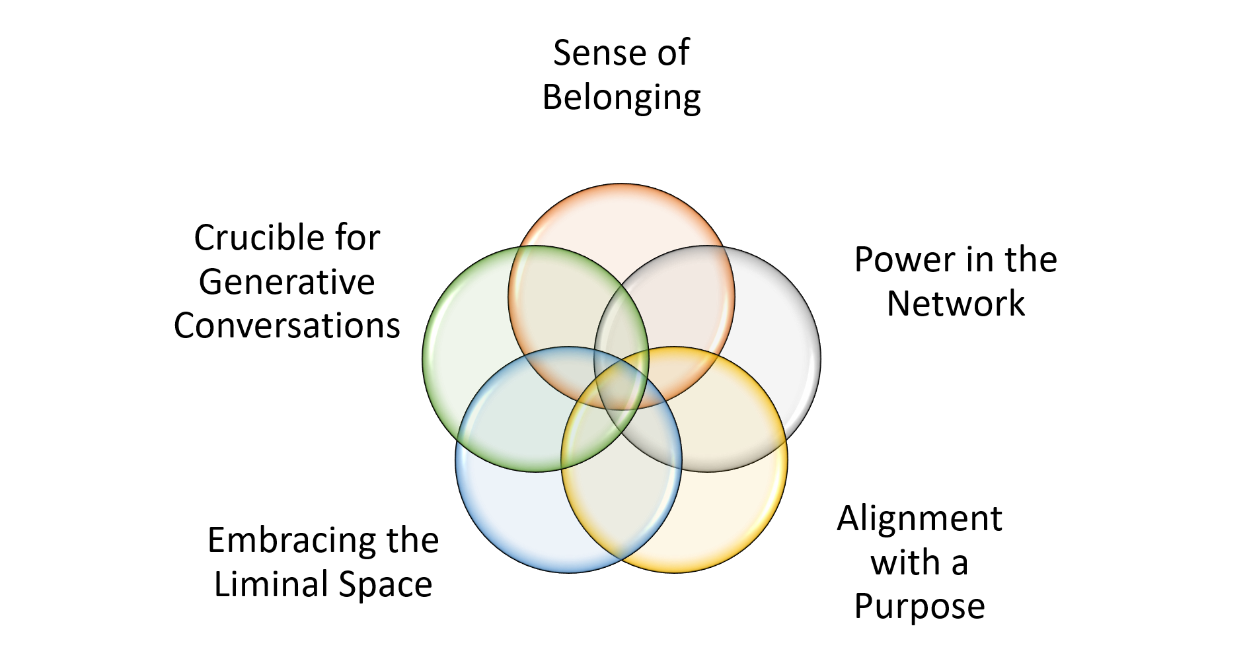
Sense of Belonging. Most often, most people, in most places are desperately trying to fit in — trying to be who they think they should be rather than who they truly are. We hardly ever feel a deep sense of belonging where we can show up in our authenticity and wholeness. There are parts of us we keep hidden knowing that they won’t be accepted. A sense of belonging doesn’t go hand-in-hand with the need to say the “right things”, to succumb to authority, with a loss of autonomy and agency, and a dread of showing up with our warts and all. True belonging comes from the freedom to be exactly who we are — confident and fearless in the knowledge of acceptance.
Communities that can create such safe spaces for everyone to show up authentically in all their uniqueness intact create the conditions for a multiplicity of voices and viewpoints to intertwine, synergize, and integrate. Such communities create the conditions for belonging characterized by invitation, inclusion, inspiration, insight, and interconnection. Only when people fully belong can they participate and contribute from their deepest and integral selves.
Amid this apocalypse, communities can provide us with solace, solidarity, and significance — a sense of being a part of something much larger than we can imagine even as we feel cut adrift from all our familiar moorings. And out of this cohesion, we gain the strength and endurance to hold space for our pain and dare to step into the future that is beckoning us — a future that must necessarily be completely different from our past. Therefore, purposefully formed communities exist at the intersection of individual agency and sovereignty while holding space for collective intelligence and sensemaking.
Power in the Network. A sense of belonging is closely aligned with “power.” We are familiar with “power over,” where some people have positional authority to wield power over others. The “others” are thus rendered powerless, robbing them of agency, sovereignty, and dignity. Dominance, coercion, and control are the keys to exerting power. Right now, most countries are experiencing some form of authoritarian and autocratic government where the latter is exercising power by controlling the resources we need to live — money, food, healthcare, livelihoods, etc., to the detriment and disadvantage of many.
A community has no place for “power over.” Here, the power lies in the spaces between people, in the networks, in the connections. It is shared power that grows out of collaboration and relationships. It is built on respect, mutual support, solidarity, influence, empowerment, and participatory actions. It hinges on the collective ability to act together for the common good. It is “power with” others — the power to collectively make a difference.
When an individual feels a deep sense of belonging and inner alignment with the community’s purpose, this translates into an experience of the “power to” make a difference. “Power to” is an inner sovereignty and agency that is felt as a movement within, an upsurge of one’s unique potential, a generative power emanating from the capacity to birth new possibilities and actions.
Sovereignty is the capacity to take responsibility. It is the ability to be present to the world and to respond to the world — rather than to be overwhelmed or merely reactive. Sovereignty is to be a conscious agent. …
Sovereignty is the center. If you are anchored in sovereignty and able to fully respond to the world, you are able to do the best you can do. ~Jordan Hall
Alignment with a Purpose. Our lives have, for the most part, shrunk to the four walls of our homes. As people shelter in place with lock-down still in effect in many parts of the world, it is easy to get lost in one’s own anxieties and fears. As our world narrows down to our homes, we run the risk of losing our sense of interconnection with the rest of humanity, and the web of life. Now is the time when we most need to come together. Not only as countries but as global citizens connected by a shared experience — perhaps for the first time in our lives.
It is human nature to want to be a part of something larger than oneself. That is the quest we are all a part of. When communities come together around a purpose that speaks to the soul, we know we have found our tribe. This feels empowering, providing meaning and anchor in a collapsing world. The pervasive uncertainty and ambiguity become bearable when we belong to a community, when we support each other in traversing this in-between space, when we are living into the questions that matter.
Embracing the Liminal Space. While as an individual, it can be overwhelming to immerse ourselves in uncertainty and stay in the in-between space, we can do this as a community. In fact, it is only as communities “exploring the intersection of the universal stories of human experience with the personal stories of our lives” can we make sense of what is happening. We can further enhance this by inquiry through multiple modes of reflection so that everyone can fine their own unique way of listening to their inner wisdom.
These can involve solitary practices like guided reflective journaling, creating vision boards, or group practices like sharing stories, music, movement, and any other art form. The idea is to listen to the subliminal voice within us, the inner source of wisdom that we suppress with our superficial cognitive prowess. When we allow this wisdom to rise to the surface, together we weave a “tapestry of truth” with many and diverse threads, creating a pattern that is inclusive, evolutionary, emergent. That includes and transcends the multitude of voices.
Staying in the liminal space asks us to be comfortable with and welcome silence. Silence can be truly generative; by not rushing to fill the silence, we create space for the universe to speak through us. Staying in silence is not a passive act but a conscious one of muting the inane mind-chatter, feeling the stillness within, and tuning into the field of resonance that is created. As we continue to explore, the possibilities latent in the liminal space emerge.
The liminal space is an invitation to surrender — an invitation to give over to something larger than self and trust that we will be held and supported with whatever we need in order to navigate the uncertainty. The degree to which we are comfortable or uncomfortable has to do with how we choose to be with what is happening. We can choose to fight against the liminal space and struggle, or to flow with it by listening, sensing, and responding. ~Alan Seale
Intentional communities help us to stay in this space between stories and navigate it together. That is when — by weaving together the kaleidoscope of narratives and perspectives — we can truly envisage a different world. I believe we are all agents of an interconnected whole, and communities are catalysts propelling us toward a regenerative future.
Crucible for Generative Conversations. This is perhaps the most important function and attribute of an intentional community — to hold space for generative conversations. I have often written about Otto Scharmer’s model of Generative Listening, the foundation of deep and authentic conversations. And I can’t repeat enough the importance of the 4th level of listening (depicted in the diagram below) in holding space for generative conversations:
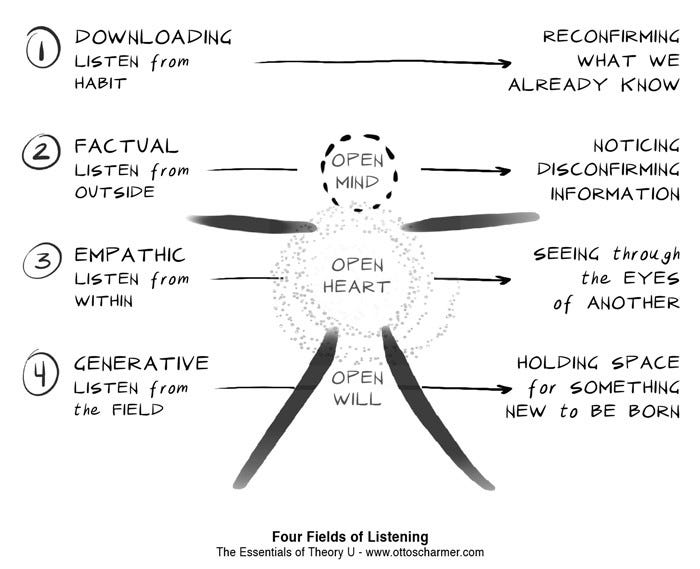
When communities become adept at facilitating “listening from the field,” they can literally listen the new into being. Real dialogue is a flow of meaning and purpose.
The Touchstones from Parker Palmer’s Circle of Trust process are also beautiful guidelines on creating an environment conducive to generative conversations.
o Give and receive welcome.
o Be present as fully as possible.
o What is offered in the circle is by invitation, not demand.
o Speak your truth in ways that respect other people’s truth.
o No fixing, saving, advising, or correcting.
o Learn to respond to others with honest, open questions.
Amid this chaos, how can we collectively hold space and sow the seeds of a different “way of being” on this planet?
Seeds of transformation lie in thoughtful, authentic, and vulnerable conversations. Every life-affirming and regenerative intention and interaction undertaken has far-reaching effect, percolates far beyond our imagination, and ultimately becomes a groundswell displacing the crumbling system.
Read part 1 HERE
Originally published HERE on June 5, 2020
Sahana Chattopadhyay is a global Speaker, Writer, Master Facilitator, Organization Development Consultant, and Coach. She works at the intersection of Complexity, Human Potential, Organizational Transformation, Systems Thinking, and Emergence. Her passion is to enable organizations to develop the capacities, skills, and mindsets to become “thrivable” in the face of uncertainty and ambiguity.
PLEASE DONATE to help Network Weaver continue in it’s mission to offer free support and resources to networks worldwide.
Related Posts
November 4, 2024
Receiving Love and Care: A Liberatory Practice
June 21, 2024

